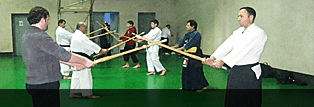History
 “Busi” (knights of the Middle Ages) used their swords “kendjutsu” (martial art with swords) according to the rules. Consequently, they ensured order and peace in IX-XVI centuries.
“Busi” (knights of the Middle Ages) used their swords “kendjutsu” (martial art with swords) according to the rules. Consequently, they ensured order and peace in IX-XVI centuries.
For Japanese people sword was and is the main weapon in the country; kendo “reigns” among the disciplines of physical training. Japanese people like to fight with a sword in the small area.
In the early period of medieval nights opposite parties fought maintaining distance from each other. In this case, first of all people addressed to archers who threw swords to their enemies like hails. But the experience showed that according to such tactics the end of the battle was vague.Due to this fact, a knight of the Middle Ages started to fight against the enemy using the close battle method what had better results. Consequently, the tactics “approaching and hitting” was the characteristic action of the medieval knights what became the usual means of conducting a battle. In “kendjutsu” victory over an enemy is mainly achieved by the attacking tactics what compels an enemy to repel the attack and make mistakes indefense.
In the middle of XVII century, those who wished to master and make his skills in “kendjutsu” perfect studied three methods of using a sword.
These methods were:
- Real sword “katana” (a sword of a Japanese samurai) and “tati” (a long sword);
- “Boken” (a wooden sword);
- “Sinai” (a lights bamboo teaching sword).
While holding a real battle or competition, worriers used one of these three types of weapon. But to fight with real swords, one should get permission from the authorities. That’s why such battle was not used in everyday practice. Thus, the battle with “boken” and “sinai” became most popular. The studies of the method of battle with such teaching methods, swords were named as “sinai-geiko”. It was kendo’s predecessor.
In order the training to be safe, it was necessary to work out the defending equipment. This problem was solved in 1711. In XIX century “sinai-geiko” gained popularity using defending equipment. Its dynamics was attractive what corresponded to the soft methods of training. In XIX century, the majority of ordinary people were already trained in “sinai-geiko”. In 1879, the authority made an official decision to accept swords, i.e. the kendo method of battle in the policy of armed forces. In 1911, kendo was the discipline of physical training in every school.
Owing to the fact that Japan was more and more inclined to the nationalism policy, the significance of kendo increased more and more not as martial art, but as a spiritual discipline and the form of physical training.
After Japan suffered defense in World War II, kendo was prohibited. It was allowed in 1948. The goals of kendo became broader and its technique improved. Such kind of kendo was accepted by international society as the base of creating the healthy type of sport for every nation.
15-18 December Event

“Busi” (knights of the Middle Ages) used their swords “kendjutsu” (martial art with swords) according to the rules. Consequently, they ensured order and peace in IX-XVI centuries....
Read More
17 March Event

For Japanese people sword was and is the main weapon in the country; kendo “reigns” among the disciplines of physical training. Japanese people like to fight with a sword in the small area. ...
Read More
Apply Now
Apply Now
Latest News:
Kendo was more realized on the battle field considering the natural rules. Kendo can be divided into three parts:
Kendo has the most ancient tradition in Japanese Culture. At first it was the means of fighting with swords.















